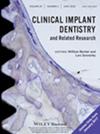A Comparative Study on the Accuracy of Implant Placement Using 3D-Printed and Milled Guides Without Metal Sleeves
Abstract
Purpose
The present study aims to evaluate whether differences in accuracy of the implant positions exist for static computer-aided implant placement based on the manufacturing process of surgical guides and the inclusion or not of metal sleeves.
Methods
Seventy-two implants (6 per model) were placed in 12 models simulating a partially edentulous maxilla using 12 dentally supported surgical guides anchored with 2 anchor pins. The surgical guides were divided into three groups: additive manufactured with a metal sleeve (Group PS), additive manufactured without a metal sleeve (Group PNS), and subtractive manufactured without a metal sleeve (Group MNS). The internal drilling diameter was standardized for all groups (4.85 mm). Deviations between the planned virtual implant positions and the scanned postoperative models were assessed in three parameters: 3D deviations at the crest, 3D deviations at the apex, and angular deviations in the implant insertion axis. The Shapiro–Wilk test was applied to analyze the normality of the sample distribution. Kruskal–Wallis and Mann–Whitney tests were used to analyze the deviations among the groups (α = 0.05).
Results
Statistical differences were reported among the groups in the parameters: 3D deviations at the crest, 3D deviations at the apex, and angular deviations in the implant insertion axis (p < 0.05). At the crest, the smallest 3D deviation was recorded in the MNS group (0.498 ± 0.337 mm) followed by the PNS group (0.660 ± 0.572 mm) and the PS group (1.028 ± 0.424 mm) (p < 0.05). At the apex, as well, the lowest deviation was observed in the MNS group (0.810 ± 0.544 mm) followed by the PNS group (0.840 ± 0.620) and the PS group (1.360 ± 0.990 mm) (p < 0.05). Regarding angular deviations, the best results were obtained by the PNS group (1.44° ± 1.57°) with statistically significant differences with both the MNS group (2.90° ± 2.35°) and the PS group (3.88° ± 2.85°) (p < 0.05).
Conclusions
The accuracy of the implant position was affected by the inclusion or absence of metal sleeves and the manufacturing method. Overall, non-sleeved guides deliver better accuracy by reducing crestal and apical deviations, as well as angular errors. Differences between the groups without metal sleeves, 3D printed and milled, were found in the implant angulation, where the 3D printed group obtained more accurate results.


 求助内容:
求助内容: 应助结果提醒方式:
应助结果提醒方式:


